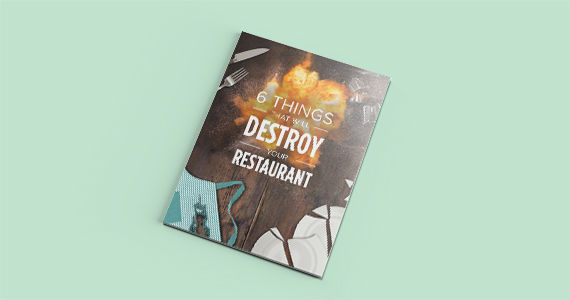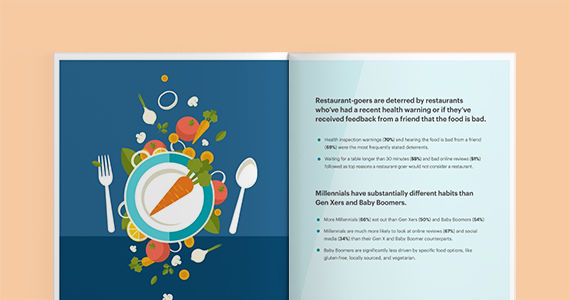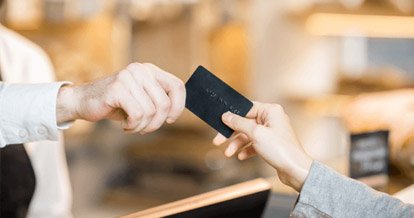What turns new customers away from your restaurant?
Empty restaurant? Nope.
Auto-gratuity? Not a deal breaker.
No healthy options? Meh.
Bad online reviews? Hmmm, well, what exactly did they say?
Long drive? Depends on the occasion.
In a recent TouchBistro survey of 500+ foodies, we asked diners what would deter them from going to a restaurant. While we weren’t exactly shocked to see a negative health inspection take the number one spot on the podium – with 70% of restaurant-goers citing it as a deterrent – we were somewhat surprised to see that a long drive, empty restaurant, and a lack of healthy menu options weren’t deterring factors for most people.
Here’s what we found:

The majority of restaurant goers were put off by general gross-ness, smack talk from peers, and long wait times: common problems that almost all restaurants will face at one point or another.
In an effort to turn these lemons into tequila shots, let’s explore how you can turn avoid deterrents and therefore avoid the eau de skunk power they could potentially have.
1. 70% of Diners are Deterred by a Recent Health Inspection Warning
No shocker here. At best a health inspection warning is like the scarlet letter of the restaurant world, marking the restaurant’s negligence and opening it up for public scrutiny. In some cases a poor inspection might shut down a restaurant entirely.
So how can you stay on top of health and cleanliness in your restaurant?
Conduct regular self-inspections. Using your city’s food service inspection guide, pick one day a month to surprise your staff with a self-inspection. By lighting a “health inspection fire” under their cabooses, you can catch any health related issues before they become the fungal rot of your business.
Use opening and closing checklists. Live by checklists, die by checklists: our brains can only be trusted with so much information after a busy night navigating the weeds. We suggest standardizing morning and night closing duties based on a restaurant health inspection checklist in an orderly, laminated list that’s easily marked off. These can include health inspection items like wiping down menus, checking freezer temperatures, and cleaning floors, so that the grime – and the risk – never build up.
Create a culture of clean. If every managing employee has their food handler’s certification and the restaurant’s culture prioritizes health and cleanliness, then maintaining standards across the chain of command is a lot easier. It’s not one person’s burden; it’s a team effort. And it’s led from the top down.

From sloppy money management to poor communication lines, know the issues that can be your restaurant’s desmise.
2. 69% of Diners Would be Deterred If They Heard From a Friend That the Food Was Bad
A mere whisper of ew! has a mighty echo down the grapevine. In our survey, “negative recommendations from friends” came in just under “negative health inspections”, which means that a negative review from a friend is almost as detrimental to your business as salmonella. So how can you prevent negative reviews of your food?
Ask for regular feedback on dishes. If a dish is consistently sent back to the kitchen, it’s time to face the facts: you need to either fix it or nix it. Start with the following:
- Ensure your sales metrics capture the dishes that are selling and those that aren’t.
- Ask staff and management to regularly check in on guests for honest feedback about their dining experience, and catalogue any feedback in a central area for further evaluation.
- Use an email survey to get feedback on the customer’s experience. (This way you also get contact information so you can market to them later! Win-win!)
- Traditional “How did we do today?” cards allow guests to share their experience honestly while maintaining anonymity.
Standardize recipes and train kitchen staff. Ensure 100% deliciousness,100% of the time with standardized recipes. When kitchen staff take gratuitous liberties, they might alter the experience of a dish from table to table and end up compromising the integrity of the dish.
Redeem yourself. Don’t let a guest leave unhappy. Whether you choose to comp their dinner, give them coupons for next time, or offer a free dessert, the recourse you take when solving a food issue might depend on the level of the guest’s dissatisfaction. Swift action is essential. Ask servers to approach the table one minute after food delivery to ensure that the table has everything they need and that the food is to to their satisfaction.
3. 55% of Restaurant-Goers Were Deterred by Wait Times of 30 Minutes or More
A long wait time, in theory, is good: it means your restaurant is full, your marketing is working, and you’re in demand. A long wait, however, can cause people to turn around and find somewhere new. Worse, developing a reputation of long waits can provoke uncertainty in customers: “Will they ever be able to seat me?”
So how can you prevent a wait list from deterring customers?
Take reservations strategically. This may seem obvious, but taking reservations for certain sections of your restaurant leaves room for those who cross their fingers and walk in. Some restaurants choose to take reservations for the dining room but leave the bar and patio open for first-come-first-serve.
Digitize the waitlist experience. When you digitize the waitlist experience through apps that allow you to send texts or in-app notifications, the diner is at liberty to get a drink at a neighboring bar, run an errand, or peruse shops while they wait.
Confirm reservations. While this may seem like a daunting task, confirming reservations during low periods is essential for keeping hosts organized and table holds accurate. Whether that means asking a host to call guests or using a reservation app to prompt guests, confirming reservations will reduce no-shows and keep your waitlists manageable.
Adhere to a strict, fifteen-minute table giveaway policy. Fifteen minutes or it’s gone. If a reservation is late beyond their table time, it’s costing you money. Make sure guests who make reservations are notified about the table giveaway cut off at the time of their reservation.
Eliminate bottlenecks. When you automate time-consuming tasks like inputting orders and taking payments, you’re turning more tables. When you turn more tables, you lower wait times, feed more more guests, and earn more tips for your servers. Here are ways to automate your dining service:
- A mobile POS for direct tableside ordering
- Enable credit card “tap” for orders under $100
- Mobile payments
As the old saying goes, “There are no problems, only opportunities.” The same goes for managing deterring factors. When you enact strategies to prevent these deterrents from occurring, you’re instilling best practices that will ensure your operations run smoothly and customers leave with high levels of satisfaction.

What gets customers in the door – and what keeps them out.
Free Restaurant Cleaning Checklist
Sign up for our free weekly TouchBistro Newsletter







